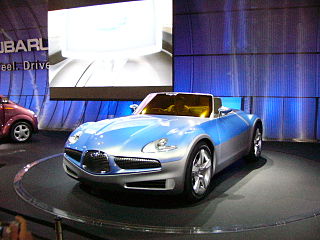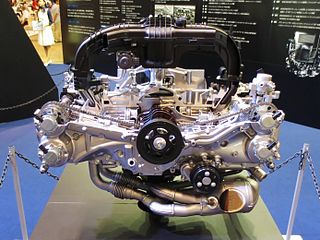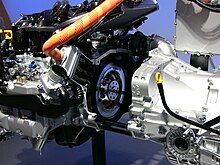
A hybrid vehicle is one that uses two or more distinct types of power, such as submarines that use diesel when surfaced and batteries when submerged. Other means to store energy include pressurized fluid in hydraulic hybrids.

A vehicle start-stop system or stop-start system automatically shuts down and restarts the internal combustion engine to reduce the amount of time the engine spends idling, thereby reducing fuel consumption and emissions. This is most advantageous for vehicles which spend significant amounts of time waiting at traffic lights or frequently come to a stop in traffic jams. Start-stop technology may become more common with more stringent government fuel economy and emissions regulations. This feature is present in hybrid electric vehicles, but has also appeared in vehicles which lack a hybrid electric powertrain. For non-electric vehicles fuel economy gains from this technology are typically in the range of 3–10%, potentially as high as 12%. In the United States, idling wastes approximately 14.8 billion liters of gasoline per year.

The Subaru B9 Scrambler is an open two-seat concept sports car from Subaru featuring classic styling. It is 4.2 metres (165.4 in) long and powered by a 140 hp (104 kW) gasoline-electric hybrid engine. It was designed by Andreas Zapatinas.

The Ford Fusion Hybrid is a gasoline-electric hybrid powered version of the mid-sized Ford Fusion sedan manufactured and marketed by Ford, now in its second generation. A plug-in hybrid version, the Ford Fusion Energi, was released in the U.S. in February 2013.
Hybrid Synergy Drive (HSD), also known as Toyota Hybrid System II, is the brand name of Toyota Motor Corporation for the hybrid car drive train technology used in vehicles with the Toyota and Lexus marques. First introduced on the Prius, the technology is an option on several other Toyota and Lexus vehicles and has been adapted for the electric drive system of the hydrogen-powered Mirai, and for a plug-in hybrid version of the Prius. Previously, Toyota also licensed its HSD technology to Nissan for use in its Nissan Altima Hybrid. Its parts supplier Aisin Seiki Co. offers similar hybrid transmissions to other car companies.

The Ford Reflex is a concept car introduced at the 2006 North American International Auto Show that, according to Ford, "proves small cars can be bold and American". It is a technological showcase that includes solar panel-powered headlights, integrated child seat, baby cam with a monitor mounted on the dash, inflatable rear safety belts, and an interior quieted by ground rubber taken from Nike athletic shoe outsoles. A production version of the Reflex design has not yet been announced. It features an advanced diesel-electric hybrid engine with new-generation lithium ion batteries that help deliver up to 65 miles per US gallon of diesel fuel, and can accelerate the vehicle from 0 to 60 mph (97 km/h) in 7 seconds.
The Dodge Intrepid ESX prototype cars are the result of the 1993 response by the Chrysler Corporation to a challenge by U.S. President Bill Clinton to produce a vehicle which was capable of meeting the demands of the modern consumer, while still achieving an unprecedented 80 miles per US gallon overall in fuel economy. The PNGV - Partnership for a New Generation of Vehicles project was aimed at The Big Three American car manufacturers.

The Subaru R1e was a battery-electric microcar produced by Fuji Heavy Industries (FHI), first shown at the 2003 Tokyo Motor Show. The concept was jointly developed to prototype form with Tokyo Electric Power (TEPCO), the giant Japanese utility company. At least 40 prototypes were built by FHI and tested by TEPCO and the New York Power Authority. The vehicle had a range of 80 kilometres (50 mi) and a top speed of 100 km/h (62 mph).
Hybrid vehicle drivetrains transmit power to the driving wheels for hybrid vehicles. A hybrid vehicle has multiple forms of motive power.

The Chevrolet Volt is a plug-in hybrid manufactured by General Motors, also marketed in rebadged variants as the Holden Volt in Australia and New Zealand and the Buick Velite 5 in China, and with a different fascia as the Vauxhall Ampera in the United Kingdom and as the Opel Ampera in the remainder of Europe. Volt production ended in February 2019.

The Mitsubishi SUW is a series of concept cars sharing a common design theme, and first exhibited by Japanese automaker Mitsubishi Motors at the 1999 Frankfurt and Tokyo Motor Shows.

Subaru (スバル) is the automobile manufacturing division of Japanese transportation conglomerate Subaru Corporation, the twenty-first largest automaker by production worldwide in 2017.

The BMW i8 is a plug-in hybrid sports car developed by BMW. The i8 was part of BMW's electrified fleet and was marketed under the BMW i sub-brand. The production version of the BMW i8 was unveiled at the 2013 Frankfurt Motor Show and was released in Germany in June 2014. Deliveries to retail customers in the U.S. began in August 2014. A roadster variant was launched in May 2018. Production ended in June 2020.

The Hyundai Blue-Will is a plug-in petrol-electric hybrid concept compact car designed by the South Korean car manufacturer Hyundai Motor Company. The vehicle was debuted at the 2009 Seoul Motor Show in South Korea.

The Subaru FB engine is the third and current generation of gasoline boxer-4 engine used in Subaru automobiles, and was announced on 23 September 2010. It follows the previous generation EJ-series engine which was introduced in 1989 and the first generation EA-series which was introduced in 1966. By increasing piston stroke and decreasing piston bore, Subaru aimed to reduce emissions and improve fuel economy, while increasing and broadening torque output compared to the EJ-series.

The Subaru VIZIV is a series of hybrid concept sports SUVs designed and built by Subaru, the first of which was unveiled at the 2013 Geneva Motor Show. The VIZIV series included several signature Subaru design features, such as the use of horizontally-opposed engines and all-wheel drive, and built on prior Subaru hybrid concepts such as the B9SC, B5-TPH, and Hybrid Tourer by using a three-motor layout. Since 2016, the VIZIV concept cars have previewed styling for upcoming production automobiles, and the hybrid powertrain has been dropped in favor of a conventional gasoline engine and all-wheel-drive.

The Hyundai Ioniq is a compact five-door liftback manufactured and marketed by Hyundai. The nameplate Ioniq is a portmanteau of ion and unique. It is marketed as the first automobile to be offered without a standard internal combustion engine, but rather sold in hybrid, plug-in hybrid, and all-electric variants.

The Subaru Hybrid Tourer is a hybrid concept sport utility/grand touring vehicle designed and built by Subaru, unveiled at the 2009 Tokyo Motor Show. The Hybrid Tourer included several signature Subaru design features, such as the use of a horizontally-opposed engine and all-wheel drive, and built on prior Subaru hybrid concepts such as the B9SC and B5-TPH by using a two-motor layout. The Hybrid Tourer was succeeded by the 2011 Advanced Tourer concept and the 2013-15 VIZIV diesel hybrid concept series.

The Subaru Crosstrek is a subcompact crossover SUV produced by Subaru since 2012. It is a successor to the Outback Sport in the US and Canada, and the Impreza XV globally. Like the Outback Sport, the Crosstrek is a lifted Impreza hatchback with minor differences, though with a more substantial lift than the Outback Sport.


















